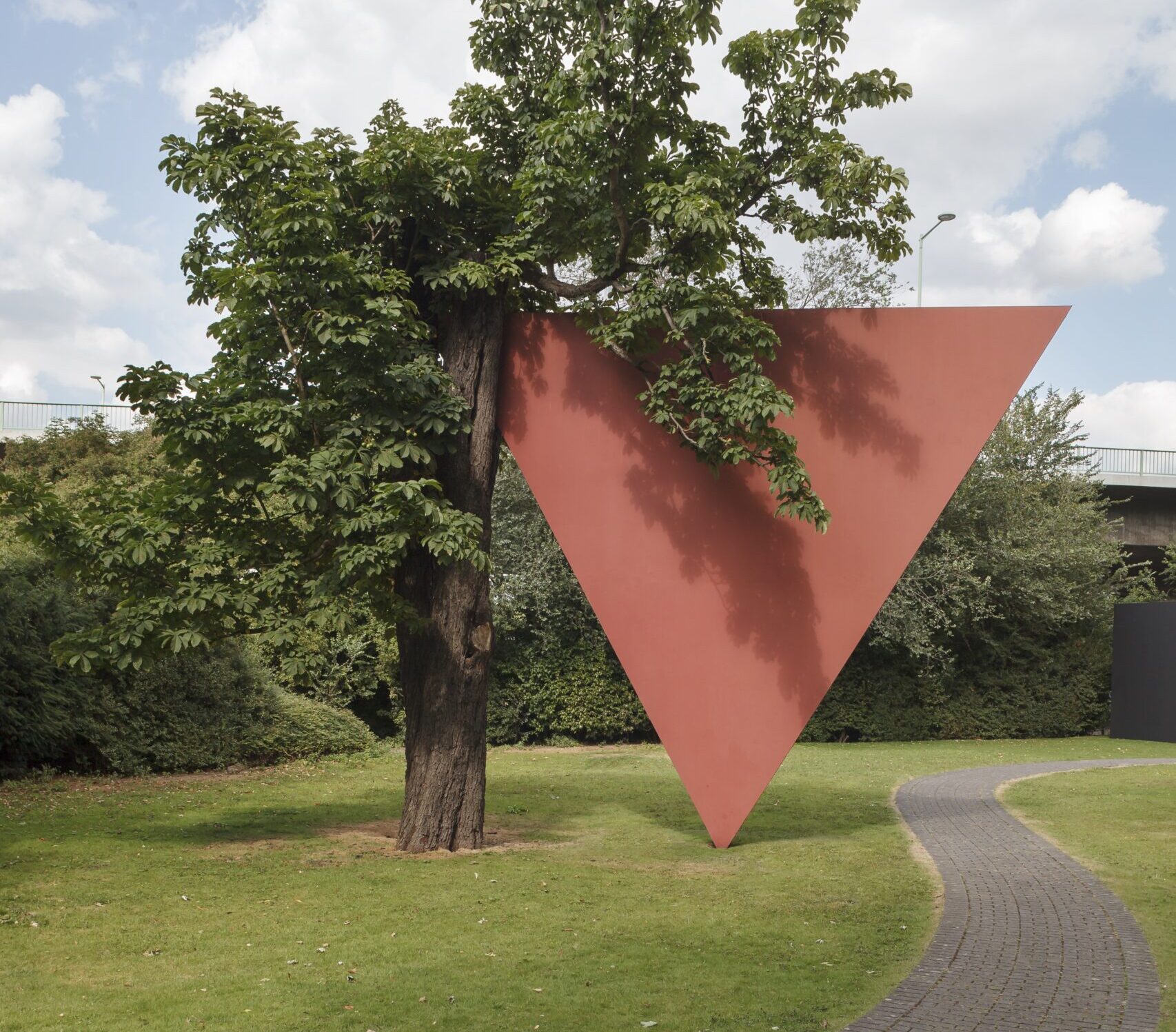Here we present a review of the successful exhibition activities since 1997.
The History: KölnSkulptur #4–10
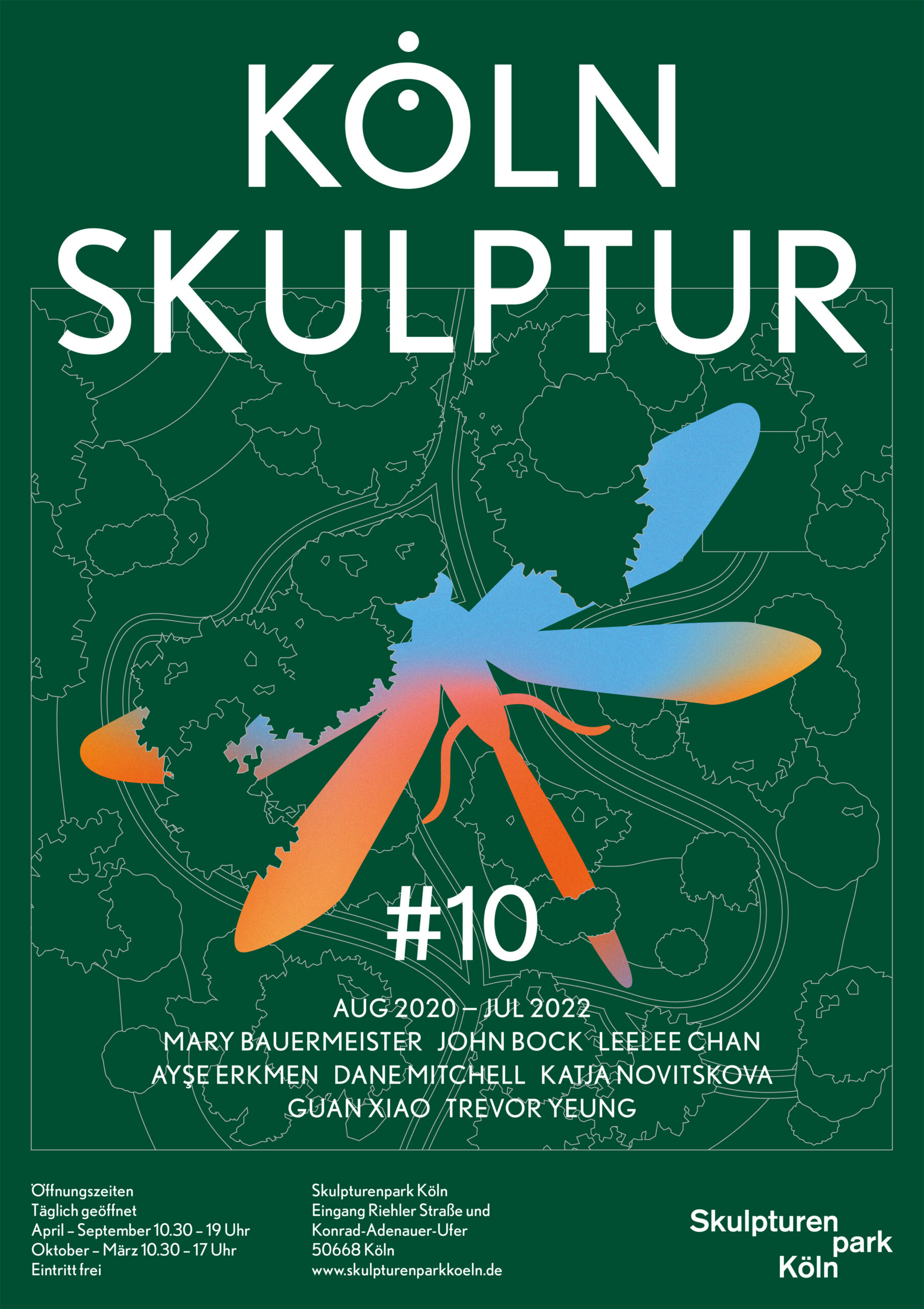
ÜberNatur – Natural Takeover
Curator: Tobias Berger
The Skulpturenpark Köln is a unique exhibition venue featuring loaned works from past KölnSkulptur exhibitions, interspersed with the permanent collection amassed by Dr Michael and Dr Eleonore Stoffel. Every two years, a curator is invited to add new artworks to this constellation of outdoor sculpture. Most of the works shown at KölnSkulptur have been commissioned especially for the exhibition. The Skulpturenpark Köln is thus a unique hybrid of permanent display and temporary group exhibition.
ÜberNatur – Natural Takeover marks the 10th iteration of the biannual KölnSkulptur exhibition of contemporary outdoor sculpture. Eight new works have been added to the Skulpturenpark Köln this year. Inspired by the location of the public park – wedged between the Rhine, the Cologne Zoo, the Flora and the adjacent Botanical Garden artworks have been commissioned or selected that engage with notions of nature and initiate dialogue with the natural environment.
Spur (2015) by Lois Weinberger can be read as the lodestar around which this year’s exhibition revolves. Commissioned for KölnSkulptur #8, it is a sixty-metre-long shallow trench cut into the ground. It has slowly developed to become a ‘ruderal community’, a living constellation of invasive weeds and a few furtive animals, which have made their home on the rough terrain. This ‘wilderness’ of weeds, a disruptive intervention in the public park, interrogates the connections between planning and planting and between idea(l)s of ‘nature’ and nature itself. This oscillation between the ‘natural’ and the ‘artificial’ – in effect a destabilisation of the two contrasting terms, which are already blurry and shifting – was a determining feature in the choice of which artworks to commission for KölnSkulptur #10. This year’s exhibition accentuates the ‘park’ in Skulpturenpark, emphasising not only its physical location, but also wider growing concerns about humanity’s place within a larger ecology – a communal ecology, in which humans, animals and plants co-exist in various constellations, all faced with the threat of climate change and ecological crisis.
KölnSkulptur #10 opens amid a devastating global pandemic, triggered by a rare spillover of a virus from wild animals to humans. Facilitated by ever-closer connections between disparate parts of the world as a result of globalisation, the virus has rampaged like wildfire across the planet, infecting millions of people.
The ‘new normal’ created by this global pandemic is causing us to view the world from novel perspectives; art and exhibitions of art are not exempt from such new interrogations. It is now of the utmost urgency that we raise awareness of the network of interconnections between striving for economic growth and globalisation and the devastating impact these can have on our natural environment. At the same time, we must not forget the visionary power of art and its ability to forge new ideas and sense-forms – not to mention its ability to refer to the ineffable beyond the relentless logic of utility and human efficiency.
Size does not define the significance of sculptural work. Sometimes small gestures can have a large impact, as can be seen in the current pandemic. Some of the works shown at KölnSkulptur #10 diverge from the expected scale of outdoor sculpture. Smaller and often barely perceptible pieces allow visitors to engage with the world at a microcosmic level, but also to widen their focus out to the larger, more unpredictable, macrocosm, in which we live.
ÜberNatur – Natural Takeover questions the monumentality of outdoor sculptures. The exhibition thus oscillates between the smallest work by Ayşe Erkmen and the largest by Dane Mitchell. Erkmen’s contribution consists of a replica of Lonely George, a Hawaiian tree snail, the last of its species, which died in 2019 after scientists spent fourteen years unsuccessfully trying to find it a mate. Mitchell’s work features two artificial trees designed to camouflage mobile data antennae and surveillance equipment, originally mass-produced in China. This piece has been imported for KölnSkulptur #10 from last year’s Venice Biennale, where it was exhibited in the context of New Zealand’s national pavilion.
At KölnSkulptur #10, visitors will encounter works that touch upon fundamental issues of birth, emergence, growth and decay, works that address both the microcosmic and macrocosmic levels of existence and that weave together diverse viewpoints to create complex connections – allowing us to sense and think with, and beyond, nature.
The crux of today’s ‘new normal’ is the need for communication, understanding and negotiation. Mary Bauermeister’s sculpture, Rübezahl, should, therefore, be read as the nucleus of KölnSkulptur #10. It offers visitors a place to sit and somewhere to reflect and contemplate. It opens up a space where taking one’s time and care and attentiveness have value, a space where nature can take hold.
Tobias Berger
Curator of the exhibition KölnSkulptur #10
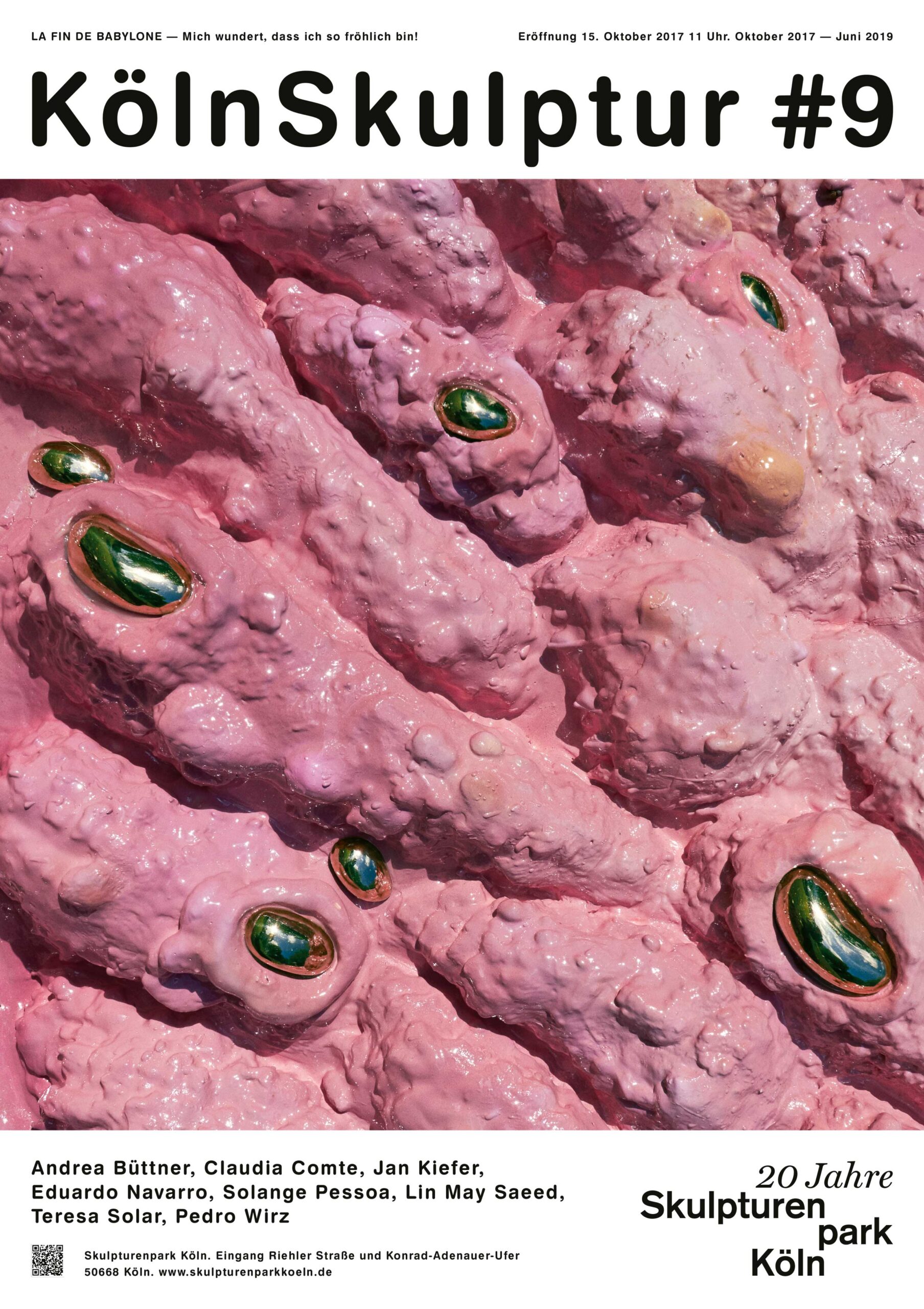
La Fin de Babylone. Mich wundert, dass ich so fröhlich bin!
Curator: Chus Martínez
This 9th edition of KölnSkulptur is a special one since the park commemorates its 20th birthday. All the works presented by the eight artists invited for the 9th edition are newly commissioned. Following the opening, a catalogue will be published.
Do you remember the “Tales of A Thousand and One Nights”? When Antoine Galland translated them into French from Arabic at the beginning of the eighteenth century, they transformed the imagination of the time. The night of the May 8, 1709, Antoine Galland made a note in his diary about an extraordinary tale the Syrian merchant Hanna Diyab had just told him: “Aladdin and the Wonderful lamp.” That night in Paris was a dramatic one, marked by riots over food shortages. Diyab arrived in the French capital during this period and turned some of the dark nights into true storytelling sessions that changed the course of a “A Thousand and One Nights”; the tales he told were added to the translation and became world heritage through literature. It would not be accurate to say that the commissioned works for the 9th edition of the exhibition series KölnSkulptur are like those tales, but the park is the perfect grounds to be inhabited by the forces of fiction. Like the character Scheherazade, the wise young woman who tells a story every night to the Sultan in order to survive, Skulpturenpark Köln is a continuous voice that recalls the possibilities we still have to survive, and it does so with art.
The Skulpturenpark Köln is not monumental in scale, and yet it is of enormous importance. Over the last two decades, the park has been the place, the site, and the home of sculptures created for it, for you. The title of this year’s edition of KölnSkulptur—La Fin de Babylone—relates to the dream of a new beginning for culture, and therefore for society. There is no such a thing, and yet there is. On the one hand, we have the life we have, our circumstances are hard to change, our possibilities hard to manifest. And there are times when we believe the past was a better place, and others when we see the time we live in as full of possibility, openness. What determines the difference between these two perceptions is the way we feel our relative importance. Oh! you may say it is economy, but even if the economy thrives, there is no guarantee that it provides a social environment in which we feel relevant to others, influential to our community, able to celebrate and partake in the current course of events… Here, I propose a total exaggeration: to imagine that the production of these eight, new site-specific works joining the already existing ones in the parcours is key to the beginning of a new world. What I ask of you is not only to walk through the park and discover the different works but to also see their existence as the wonder that may affect the world order. This is out of proportion, because so is art.
And thus the second part of the title: Mich wundert, dass ich so fröhlich bin! This sentence, full of healthy humor, relates not to us but to the effort art makes to be great every time it happens. It is art and artists that produce under the assumption that it is really worth it to intervene, and add to the park not as if it is a piece of land but the whole world. This needed “exaggeration” is what motivates a thinking about the possibility of influence, which is both simple and complex.
This may be the reason why the different pieces that comprise this edition are rather unmonumental. They already embody an enormous ambition to affect the real, to touch us in such a way that every bit of skepticism of and cynicism towards the importance of art might be erased. And once liberated from the burden of doubt, we will all experience a new joy.
Chus Martínez
Curator of the exhibition KölnSkulptur #9
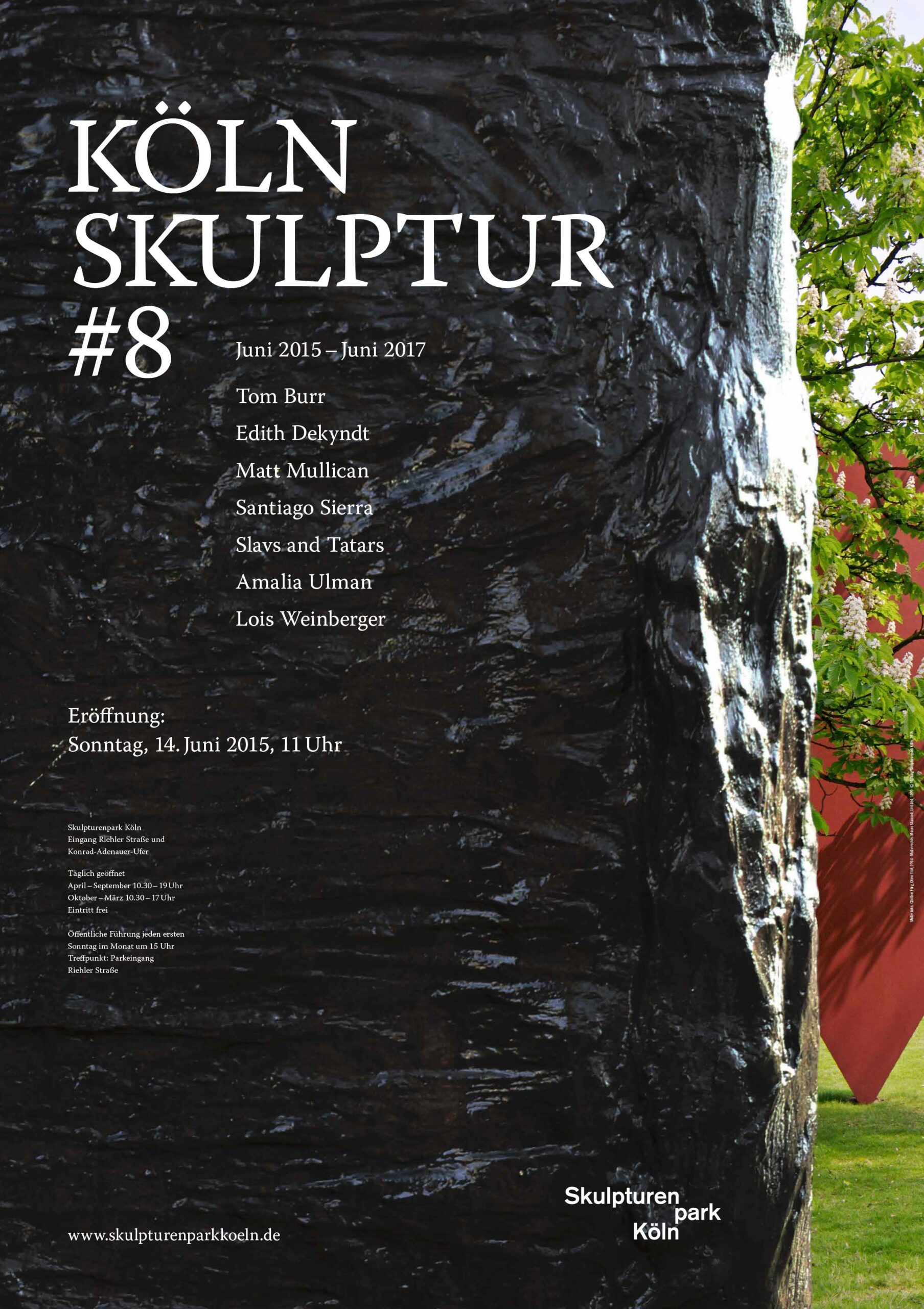
Curator: Thomas D. Trummer
KölnSkulptur is a biennial series of exhibitions at Skulpturenpark Köln. It was initiated by the park’s founders, Dr Michael and Dr Eleonore Stoffel. KölnSkulptur #8 is the eighth new show and can be viewed from June 2015 onwards. Encircled by busy thoroughfares, Skulpturenpark Köln occupies an area that is quiet enclave and urban periphery, park and no-man’s-land simultaneously. It is this space-defining tension which Thomas D. Trummer was drawing on when he chose the artists for the current exhibition. Seven new artworks are on display, five of which are commissions. They all deal with the ideas of framing or the opposite, exclusion. The unshakeable, defiant presence of these monuments is supposed to inspire thought about contemporary political developments in Germany and Europe. They act as view obstacles and thematically stand for opposition, work and migration, for movement and rejection.
‘Sculptures are statements of dissent, not ornamental islands.’
Thomas D. Trummer
The US conceptual artist Tom Burr is showing mirrored screens placed on the lawn, thus creating a forest of darkened, reflecting and distorting surfaces. Lois Weinberger, native of Tyrol, draws an aisle through the park, at the same time tear and cut, serving as road of invasion for immigrant plants. The art collective Slavs and Tatars is dealing with the migration of languages and the common root of Abrahamic religions by having a giant chain of prayer beads protrude from the ground. Amalia Ulman, born in Buenos Aires, is showing a wheelchair, miming the small wire mesh-constructions peddled by Latin-American migrants in their new home California. In parallel, the artist’s voice can be heard from an audiotape. Edith Dekyndt from Belgium works with ephemeral phenomena like wind, weather or tidal movements. She covered the steel entrance doors with copper. Climatic influences will eventually give the copper a green patina and in this way integrate it with surrounding nature. Santiago Sierra, resident of Madrid, is showing a giant black concrete cube. On its sides, metal figures show the working hours needed to produce it. The imposing block is like a flawless Kaaba, telling a story of hardship, work and exploitation. The US artist Matt Mullican, currently living in Berlin, visualizes his encyclopaedic world system on two benches, inviting visitors to sit down, but also to decipher the code.
Thomas D. Trummer left the biggest part of the permanent collection in the park, but created new emphases by moving some artworks. Among these are the works of the two German artists Ulrich Rückriem and Günther Förg.
Ulrich Rückriem is a sculptor, who lives in Cologne and London. He cuts his sculptures directly from the rock in the quarry and refrains from any further manipulation. The drillings and cracks in the granite remain visible. An ensemble of four blocks is now positioned centrally in the park. Günther Förg, who mainly worked as graphic artist and painter, has a high-rising bronze highlight the traces of manual work: grooves, tracts, knots and plastic modelling masses are reminiscent of the originally soft and pliable consistency of the material. At the same time the block is an insurmountable architectural element, it opposes the visitor as gestural wall.
Thomas D. Trummer
Curator of the exhibition KölnSkulptur #8
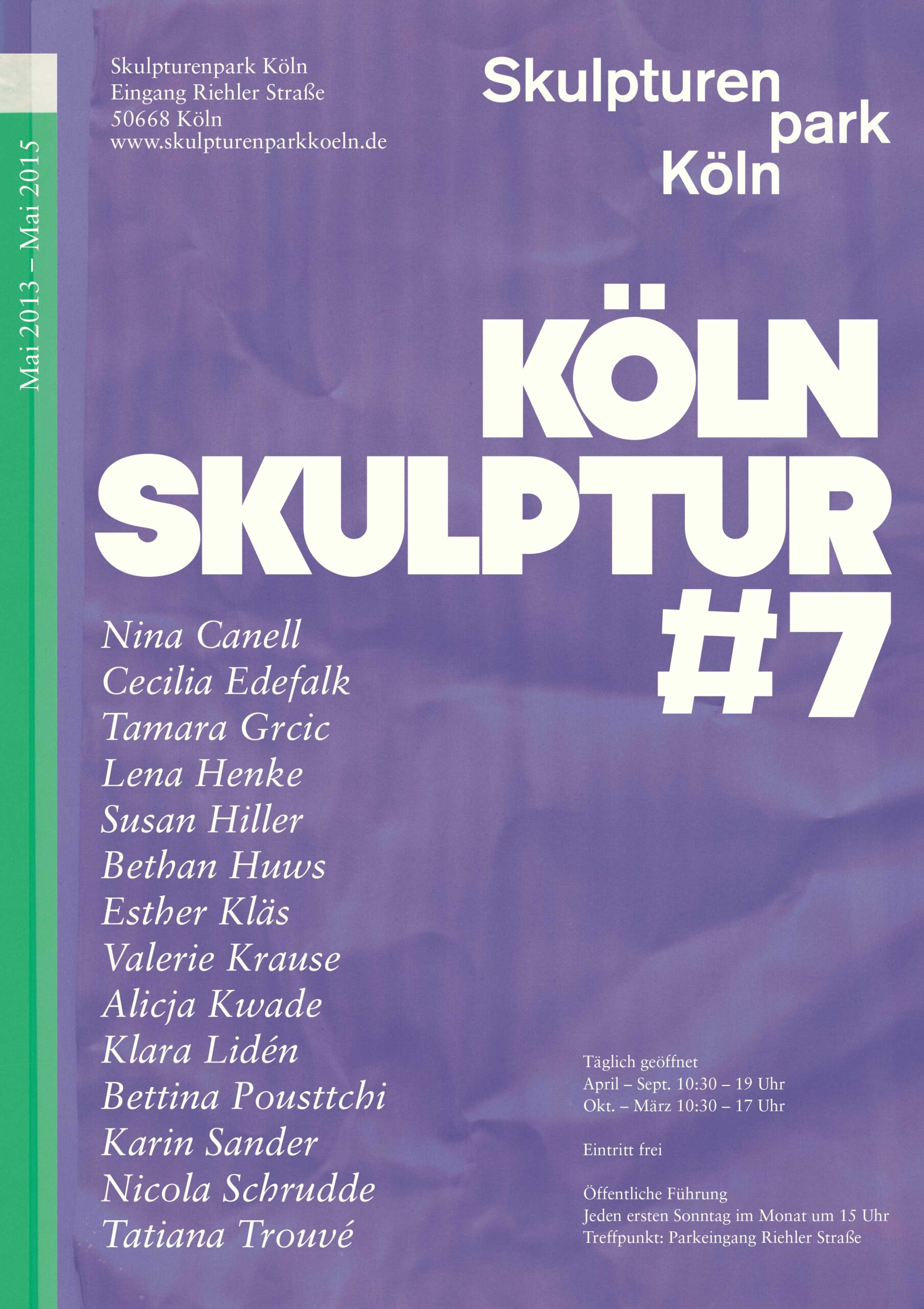
KölnSkulptur #7
Curator: Dr. Friedrich Meschede
The restaging of the Skulpturenpark Köln, visible from May 2013 to spring 2015, has to be looked at bearing in mind the previous KölnSkulptur #6 because substantial changes had come along with it. The park’s area has been enlarged since and additional spaces have been created, offering new vistas. Since 2011, the Garden Gallery, an open pavilion, dominates the park and this work by the Japanese architect Sou Fujimoto gave a new landmark to the park. Furthermore, Florian Slotawa’s work Kölner Reihe started off an unusual and surprising formal dialogue between focal points of the sculpture park’s collectional history. Slotawa’s concept, to only have assembled the seven pieces of the Kölner Reihe temporarily, forced KölnSkulptur #7 to place the works in new positions where they could resume their autonomous presence.
Bearing this in mind, the new positionings in the exhibition KölnSkulptur #7 follow the tradition of all previous exhibitions and together with the current contributions set the agenda for a contemporary tendency in sculpture which is characterised by sculpture as an idea with reference to an existent situation. The Skulpturenpark Köln can be read as a place that with its versatility of different perspectives offers visitors time, leisure to linger and ponder the different materials. Consequently, Karin Sander has chosen seven places which invite visitors to take a rest, sitting down on circular mats of synthetic turf. The manufacturer calls this product, selected by Sander from a range of almost one hundred, Paradise 231, which in turn broadens the interpretational horizon within the park’s context. Bethan Huws has had a multi-part ladder put up, which, pointing skyward, steers associations towards the scaling of dreams with its purpose-free undirectedness. The disused power pole by Nina Canell seems like the ruins of a post-modern age, a reminiscent of the utopia of those years in which no one had to worry about energy. Against the background of the city skyline, the pole becomes a cautionary object that sends the message at the same time not to be networked any longer in the park. Close by, Susan Hiller has had her acoustic work installed, which, originally conceived for a Landesgartenschau, transforms Mendel’s inheritance laws into a sound installation. It seems as if Édouard Manet’s famous 1863 painting The Luncheon on the Grass has become a point of reference not only for Karin Sander, but also for Alicja Kwade, denoting an idyll which has become a common good: the raw, untreated boulders of different kinds of stone have been placed like a living room suite in the open, seemingly offering the opportunity to carve sitting, lying or standing figures, sculptures-to-be, thus visualising the ancient Pygmalion topic as a process of the internal imagination. Klara Lidén achieves such a transformation in a most astonishing way: in the very place where the steel container sculpture by Sofia Hultén used to sit, now there appears a hedge, cut in the shape of a container. On the way there, the ground work of Esther Kläs shows a piece made of coloured concrete whose shape leaves it to the viewer whether to see a body impression or a shape created in the form of a vessel – again, creating the ultimately indefinable expression is the aim of the form. With her tripartite work, Lena Henke refers to graffiti-photographs by Brassaï. The work Elisabeth by Bettina Pousttchi alludes to a street name in Berlin, where the artist has found these elements and arranged them to a new composition as such. One of the previous landmarks of the Skulpturenpark Köln had to be removed into storage for safety reasons. The spectacular space is now used by Cecilia Edefalk for a bronze which in a camouflage of a birch branch likens this place to a quasi-archaeological site. A second bronze near the passage leading to one of the three bunkers dominating the Skulpturenpark Köln plays with this theme of the mise-en-scène of places. Also the casting moulds of Tatiana Trouvé’s sculpture play with the surrealist tradition. Her voluminous casts of paper bags in connection with bronze-cast shoes suggest the absence of figures commanding this space. The ceramic forms of Nicola Schrudde are searching for a similar archaicism with organic shapes protected by a miniaturised glass house. Valerie Krause places a horizontal picture in a window of Sou Fujimoto’s garden pavilion, thus establishing a relation between a close horizon and the grand panorama of the river Rhine. An unusual contribution by Tamara Grcic invites new guests to stay in the park. She placed nesting boxes for parakeets high up in the tree tops of two plane trees to offer the offspring of Cologne Zoo a new home. The birds’ green plumage lends a vivid colouring to the park which is in motion continuously and gives visitors the opportunity of experiencing situational moments of lightness while viewing the new works.
Dr. Friedrich Meschede
Curator of the exhibition KölnSkulptur #7
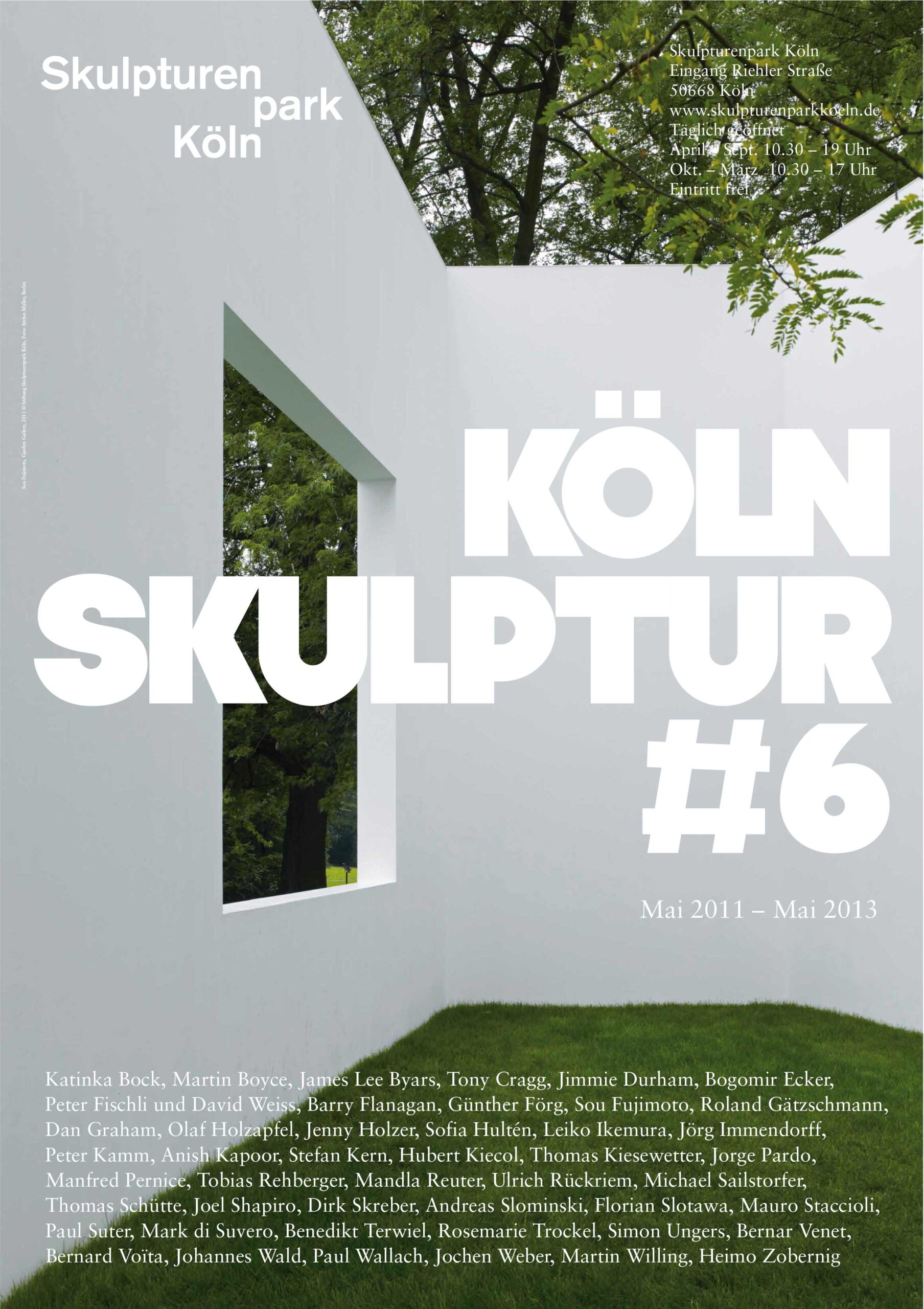
Curator: Dr. Friedrich Meschede
The exhibition KölnSkulptur #6 has cast the park run by Stiftung Skulpturenpark Köln in a completely new perspective: the park grounds have been extended and can be experienced in a host of ways thanks to the sightlines and routeways.
At the centre of the new concept is a garden pavilion by Japanese architect Sou Fujimoto, which through its size, shape and alignment forms an antithesis to the foundation’s now publicly accessible building. This Garden Gallery continues the tradition of classical park architecture and will serve as the pivot for works that are already in the park and that pick up on motifs in the architecture, such as the already existent sculptures by Jorge Pardo, Heimo Zobernig and Dan Graham. This direction in sculpture, which is informed by architectural motifs, can be seen in new works by Olaf Holzapfel and Bernard Voïta.
Another major pivotal point is the project by Florian Slotawa, whose contribution Kölner Reihe has set out to produce an objective presentation of the works in the collection: seven pieces from the park, which all may be considered landmarks in the original idea for the sculpture park, are arranged in a row according to size. With this the works that previously had been scattered about in a decentralised manner will be concentrated together as an exhibition within an exhibition and spark an unexpected dialogue on the formal connections they share between lines and volumes. The new works all share a concern with materials and their processing, in the manner already indicated by the works in the park by Ulrich Rückriem – sculptures that combine minimalist forms with a kind of narrative and that reveal themselves as a process of seeing: a boulder covered by a hide by Johannes Wald, Jimmie Durham’s monumental tree trunk that hails from foreign climes, a terracotta sculpture by Katinka Bock that will only later be fixed in ceramic form, a sandstone sculpture by Peter Kamm that seems like a surreal, fossilised element, objets trouvés for which Benedikt Terwiel has found new locations, and the container which Sofia Hultén presents to us as an abstract volume. We approach a tree that has been put in our way by Mandla Reuter and are given a view over the park from a bench made of recycled wood – a seat sculpture by Jochen Weber. And a seemingly crystalline object on a table by Roland Gätzschmann has the air of a still life. Finally, we encounter new works by Martin Boyce, Thomas Kiesewetter, Hubert Kiecol and Thomas Schütte that can be termed autonomous, but which in their own ways theme their locations in the park.
KölnSkulptur #6 sets out to redefine a handed-down theme and with that to reinvent itself. Above all, its objective is to invite the visitors to linger while looking, so as to grasp the sightlines from the reference point of their own free-ranging associations as an individual experience in seeing. Sculpture is the art of physical experience within the space of space.
Dr Friedrich Meschede
Curator of the exhibition KölnSkulptur #6
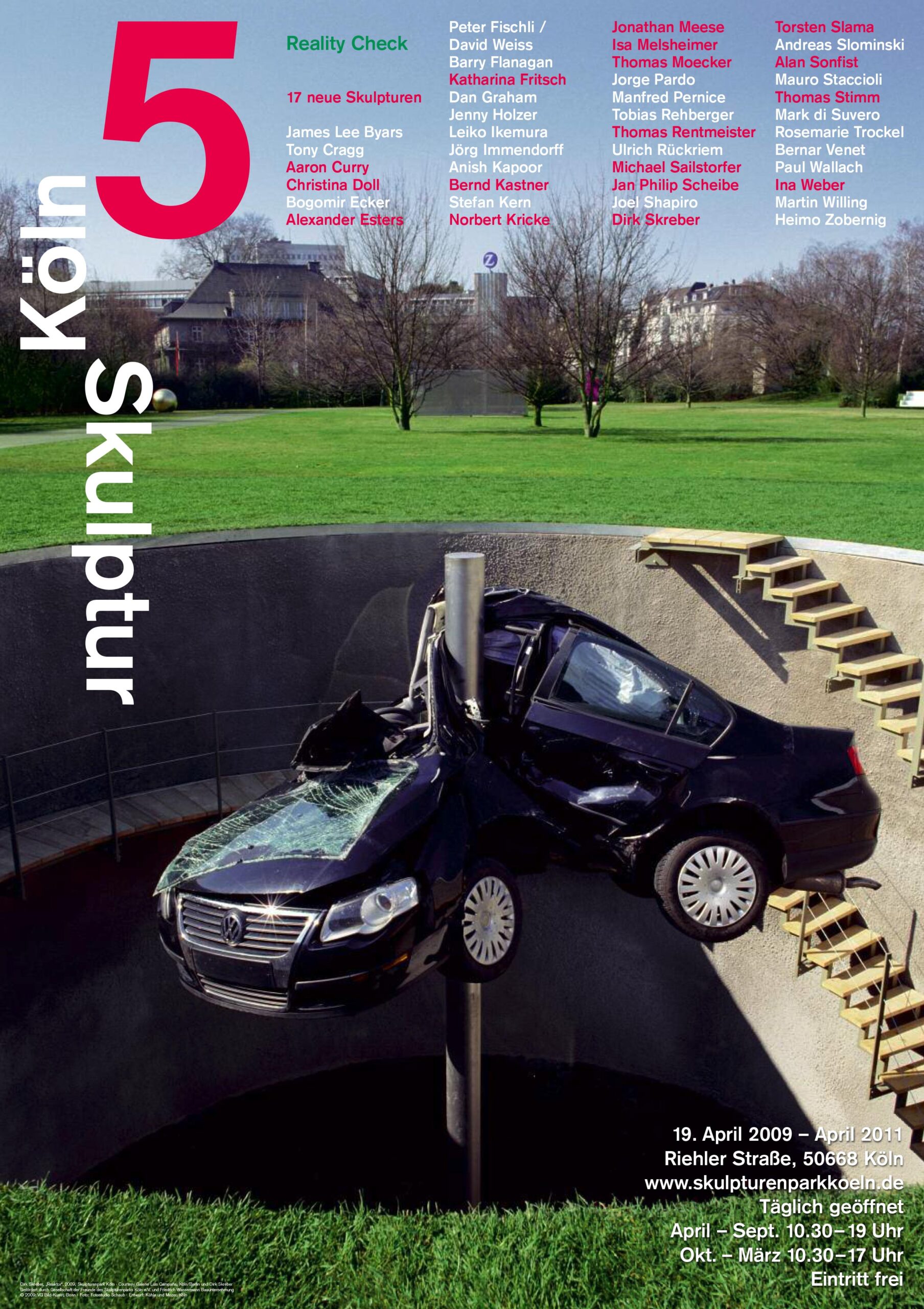
Reality Check
Curator: Dr. Renate Goldmann
With the exhibition KölnSkulptur #5, the Skulpturenpark Köln is showing numerous outdoor sculptures by national and international artists. A total of 41 works can be seen on the spacious grounds between the zoo and the Rhine, 17 of which are new positions refering to the new exhibition. In addition to a representative look at positions of contemporary outdoor sculpture, KölnSkulptur #5 – Reality Check enables visitors to confront the reality of the 21st century and thus opens up not only new personal perspectives, but also exciting discussion bases that stimulate exchange.
Dr. Renate Goldmann
Curator of the exhibition KölnSkulptur #5
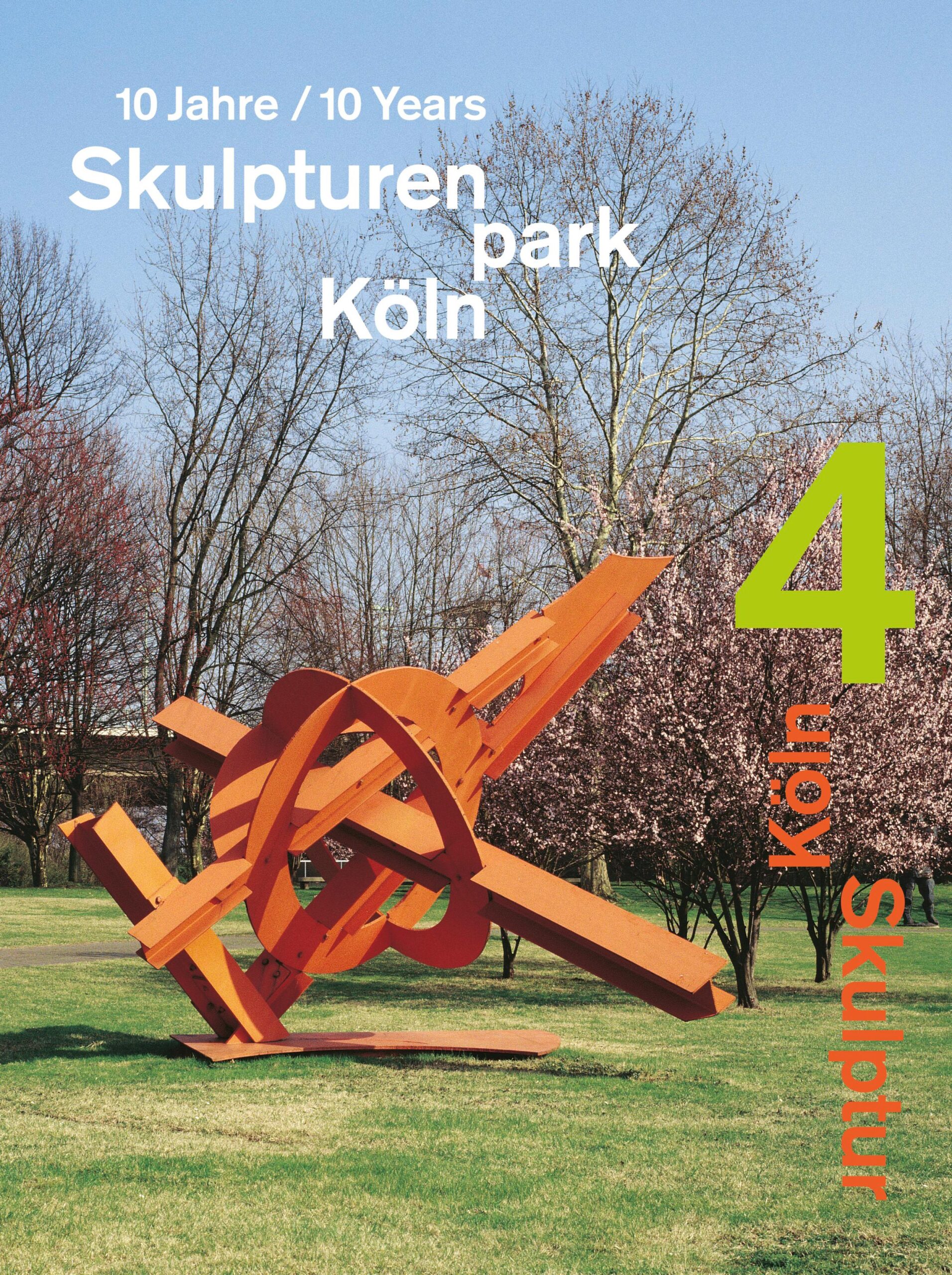
10 Years Skulpturenpark Köln
Curator: Dr. Renate Goldmann
With KölnSkulptur #4 the Skulpturenpark Köln celebrating the 1oth anniversary.
The first exhibitions in the Skulpturenpark Köln
The first three exhibitions were still curated by an sculpture committee. From KölnSkulptur #4 onwards, changing curators were appointed.
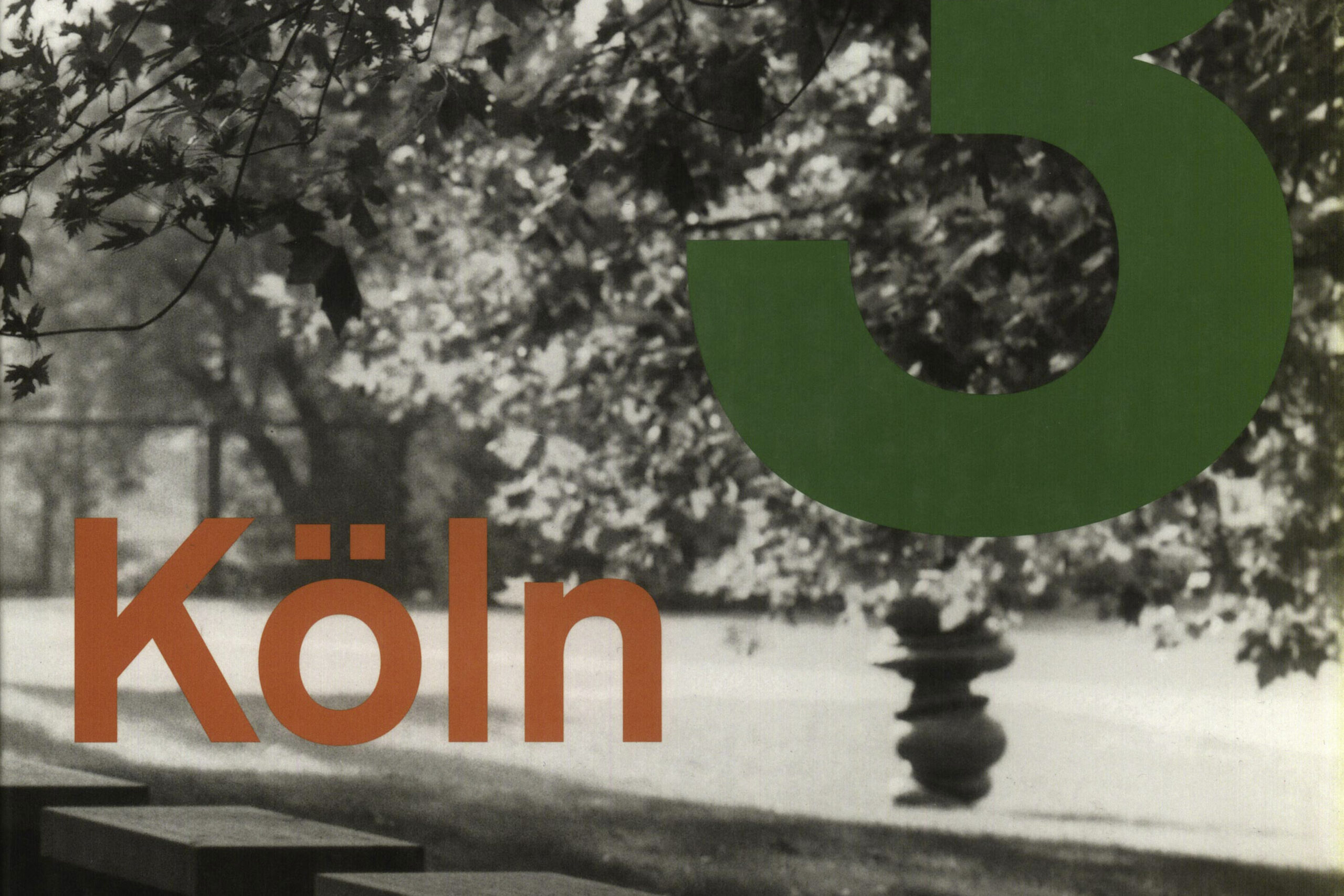
Curator: Sculpture Committee
With KölnSkulptur #3, the Skulpturenpark Köln is showing numerous outdoor sculptures by national and international artists. The exhibition was curated by a sculpture committee that included Prof. Dr. Siegfried Gohr, Dr. Veit Loers, Dr. Eleonore Stoffel, Dr. Michael Stoffel and Prof. Dr. Armin Zweite.
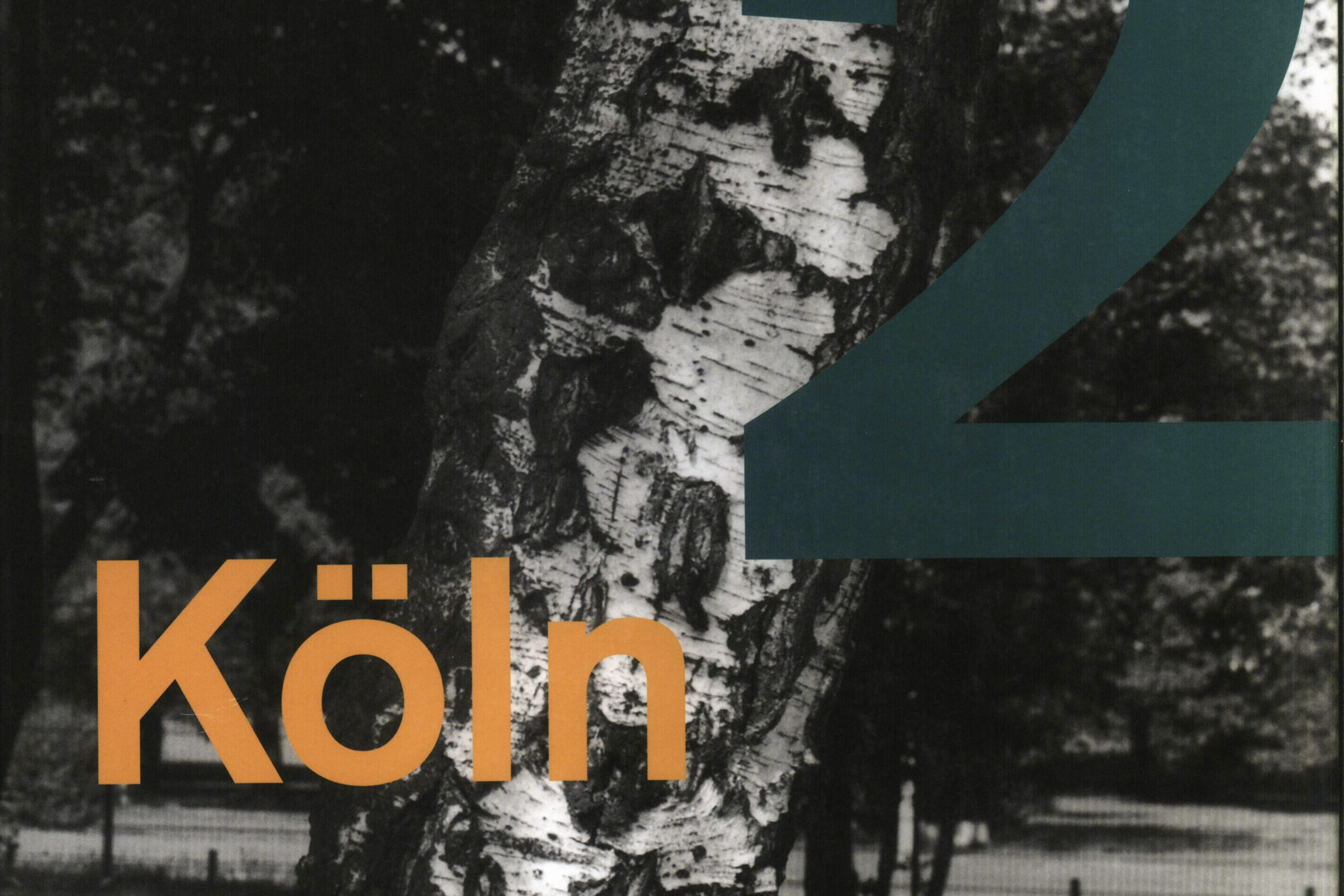
Curator: Sculpture Committee
With KölnSkulptur #2, the Skulpturenpark Köln is showing numerous outdoor sculptures by national and international artists. The exhibition was curated by a sculpture committee that included Dr. Veit Loers, Dr. Eleonore Stoffel, Dr. Michael Stoffel and Prof. Dr. Armin Zweite.
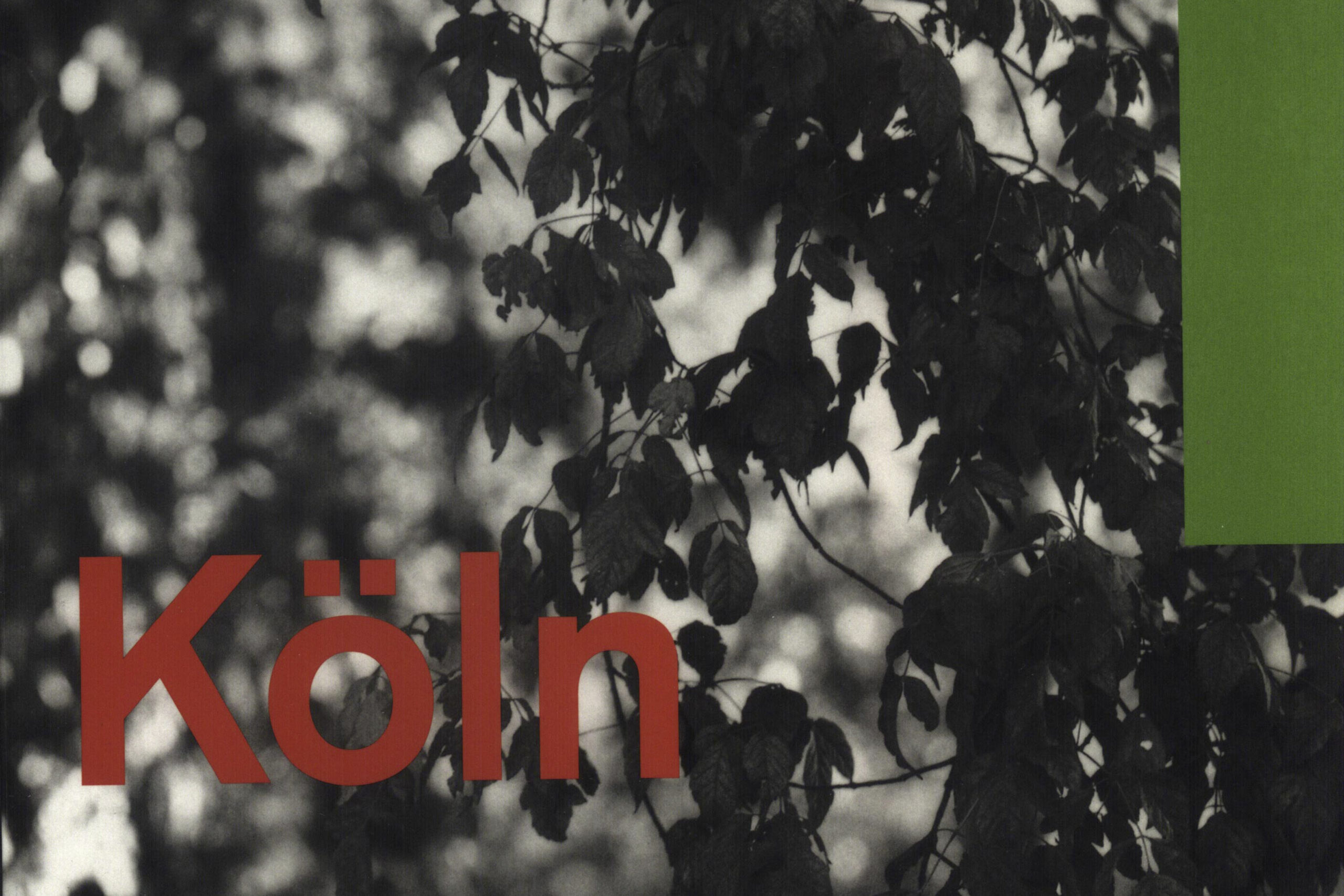
Curator: Sculpture Committee
With KölnSkulptur #1, the Skulpturenpark Köln is showing numerous outdoor sculptures by national and international artists. The exhibition was curated by a sculpture committee that included Dr. Veit Loers, Dr. Eleonore Stoffel, Dr. Michael Stoffel and Prof. Dr. Armin Zweite.
